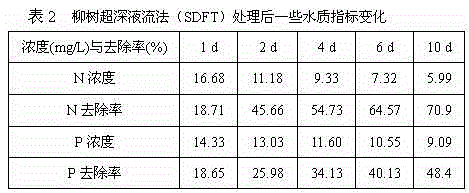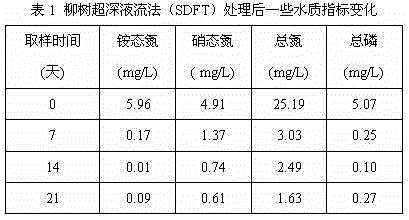Method for purifying domestic wastewater by using willows through super deep flow and application thereof
A domestic wastewater and deep liquid flow technology, applied in the field of environmental restoration, can solve the problems of increased sewage treatment volume, small wastewater treatment volume, and low purification efficiency, and achieve the effect of improving purification efficiency, large nutrient demand, and soft texture
- Summary
- Abstract
- Description
- Claims
- Application Information
AI Technical Summary
Problems solved by technology
Method used
Image
Examples
Embodiment 1
[0026] The application example is implemented in the experimental farm of Zhejiang University, and the domestic sewage is taken from the Huajiachi campus of Zhejiang University. The specific steps include the following:
[0027] Collect the branches of the annual Goji willow with no pests and diseases and healthy growth, with a thickness of 1 cm. Cut into 10-20cm cuttings, and the end of the cuttings is obliquely cut. In order to promote rooting and reduce the inhibition of secondary biomass in the roots, soak the cut cuttings in water for 24 hours. Choose a 5cm thick PF board as the carrier, and cut the cuttings directly on the PF board according to the row spacing of 10×15cm.
[0028] Build a water tank with a depth of 50 cm, a width of 45 cm, and a length of 500 cm. A cement tank with a wall thickness of 6 cm is coated with a waterproof paint to prevent water seepage.
[0029] Move the PF board with cutting strips to the cement tank, and operate according to the following ...
Embodiment 2
[0035] The experiment was carried out in the greenhouse of the experimental farm of Zhejiang University. The cement tank was built with bricks and cement on the ground. The length of the cement tank was 5 m, the width was 40 cm, and the depth was 50 cm. The tank wall was coated with waterproof paint to prevent water seepage .
[0036] The 1-year-old branches of Willow barbarum were collected, with a thickness of 1 cm, and made into 10 cm cuttings, which were neatly inserted on phenolic foam boards with a thickness of 3 cm at a plant spacing of 10 × 15 cm (foam boards with a length and width suitable for sinks).
[0037] Move the PF board with cutting strips to the cement tank,
[0038] In the first stage, the cement tank is filled with tap water to a depth of 10 cm to root the cuttings. The root system is well developed and the seedling height is 30 cm.
[0039] Then inject Huajiachi lake water (N concentration is 15.28 mg l -1 , with a P concentration of 15 mg l -1 ). Us...
PUM
| Property | Measurement | Unit |
|---|---|---|
| diameter | aaaaa | aaaaa |
Abstract
Description
Claims
Application Information
 Login to View More
Login to View More - R&D
- Intellectual Property
- Life Sciences
- Materials
- Tech Scout
- Unparalleled Data Quality
- Higher Quality Content
- 60% Fewer Hallucinations
Browse by: Latest US Patents, China's latest patents, Technical Efficacy Thesaurus, Application Domain, Technology Topic, Popular Technical Reports.
© 2025 PatSnap. All rights reserved.Legal|Privacy policy|Modern Slavery Act Transparency Statement|Sitemap|About US| Contact US: help@patsnap.com


